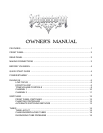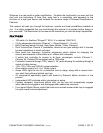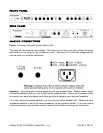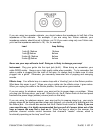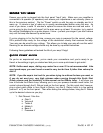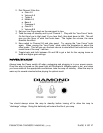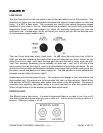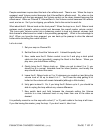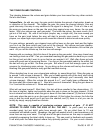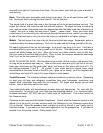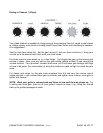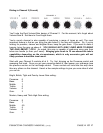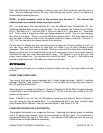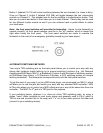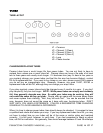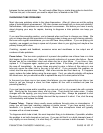PHANTOM OWNER’S MANUAL (rev.2) PAGE 8 OF 17
THE TONE/VOLUME CONTROLS
The interplay between the volume and gain dictates your tone more than any other controls.
So let’s start there.
Volume/Gain. As with any amp, the gain control dictates the amount of saturation, break up
or distortion of the channel. The higher the gain, the more the channel distorts. Like any
good tube amp, this amp is very sensitive to the signal it is being fed. Think of it like a car,
the more you press down on the gas, the more then engine turns over, hence, the car goes
faster. Well your pickups are your gas pedal. The hotter the pickup, the more crunch you’ll
get out of the amp. So, with a low output (maybe, say, a single coil), the more sweep you
have on the gain knob before the amp will start to provide more crunch. For us metal
players, our super high output pickups will cause this channel to distort much more quickly.
For gain settings, generally your cleaner tones will be lower on the gain knob and the higher
you run it up, the more crunch you’ll get out of the channel. But volume and gain interplay.
Assume you dime the gain, but set the volume to 1. You’ll hear the distortion, but not like you
want. As you roll the volume up, the true tone will emerge.
Keeping with our analogy, think this time of the gain as the gas pedal. How many times have
we raced go karts as a kid? Can you remember mashing the gas pedal as hard as you could
but the go kart just didn’t want to go as fast as you wanted it to? Well often those go karts
came with some sort of governing device. You can put the proverbial pedal to the metal, but
the kart will only go so fast. So dime your gain. But when it’s not fast enough, open up that
governor by introducing some volume. As you bring up the volume and heat up the channel,
mashing that gas pedal starts to really get that machine moving.
When deciding how to run your volume/gain settings, try some things first. Bring the gain up
to around 7 and volume to around 3. After you’ve made mental note of the tone, start rolling
that volume up and listening for the tonal changes (although you’ll assuredly also hear
volume changes). When the volume hits around 6 or 7, you’ll really hear a difference from
the tone when the volume was on 3. Now let’s reverse it somewhat. Bring the gain down to
2 or 3 and set the volume at 3. Rinse and repeat.
What will we have learned? Most likely, this test will have resulted in few observations: (1)
the tone is brighter, tighter and punchier when the gain is down on the gain channel; (2) the
tone is cleaner and rounder when the gain is down on the clean channel; (3) the tone is mean
and nasty when the gain is up on the crunch channel; (4) the higher the volume, the fuller the
amp is and the more punch you’ll get from the channel; and (5) there is a lot you can do
tonally by simply varying these two controls.
NOTE: This amp is capable of producing extreme amounts of gain. IT IS NOT
ADVISED TO EVER TURN THE GAIN UP ALL THE WAY. In year’s past, our amps
sounded great, but just didn’t quite have enough gain. So we rolled them to 10 and
sometimes still added a pedal. Nowadays, the gain we wanted is built in and sometimes a lot
more than we may ever need. The high end of the gain structure on this amp is capable of
potentially surpassing the tube’s ability to keep up. This can result in feedback and squeals.
It will also push the tubes beyond where they optimally perform. On your crunch channel,



